Class 10 Maths
Triangles

Ex. 6.1 Q.1
Fill in the blanks using the correct word given in brackets:
(i) All circles are __________. (congruent, similar)
(ii) All squares are _______. (similar, congruent)
(iii) All ___________ triangles are similar. (isosceles, equilateral)
(iv) Two polygons of the same number of sides are similar, if (a) their corresponding angles are _______ and (b) their corresponding sides are _______.(equal, proportional)
View Answer
Ex. 6.1 Q.2
Give two different examples of pair of
(i) similar figures.
(ii) non-similar figures.
View Answer
Ex. 6.1 Q.3
State whether the following quadrilaterals are similar or not:
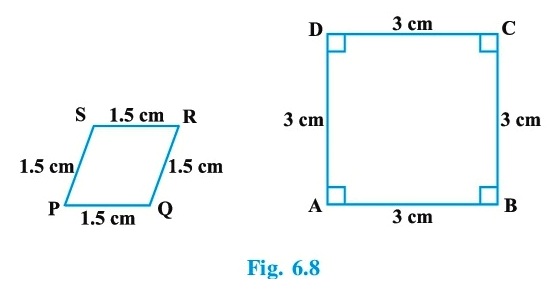
View Answer
Ex. 6.2 Q.1
In Fig. 6.17, (i) and (ii), DE || BC. Find EC in (i) and AD in (ii)
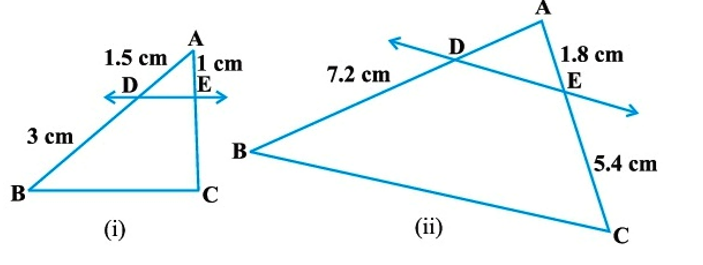
View Answer
Ex. 6.2 Q.2
E and F are points on the sides PQ and PR respectively of a Δ PQR. For each of the following cases, state whether EF || QR:
(i) PE = 3.9 cm, EQ = 3 cm, PF = 3.6 cm and FR = 2.4 cm
(ii) PE = 4 cm, QE = 4.5 cm, PF = 8 cm and RF = 9 cm
(iii) PQ = 1.28 cm, PR = 2.56 cm, PE = 0.18 cm and PF = 0.36 cm
View Answer
Ex. 6.2 Q.3
In Fig. 6.18, if LM || CB and LN || CD, prove that AM/AB = AN/AD.
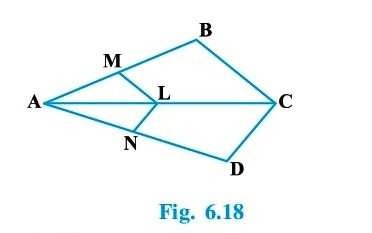
View Answer
Ex. 6.2 Q.4
In Fig. 6.19, DE || AC and DF || AE. Prove that BF/FE = BE/EC.
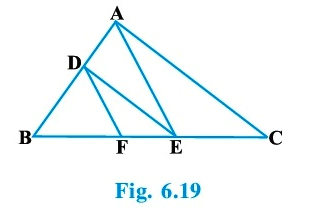
View Answer
Ex. 6.2 Q.5
In Fig. 6.20, DE || OQ and DF || OR. Show that EF || QR.
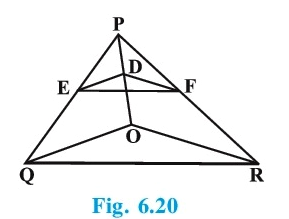
View Answer
Ex. 6.2 Q.6
In Fig. 6.21, A, B and C are points on OP, OQ and OR respectively such that AB || PQ and AC || PR. Show that BC || QR.
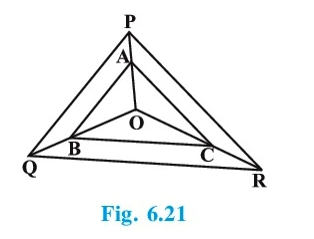
View Answer
Ex. 6.2 Q.7
Using Theorem 6.1, prove that a line drawn through the mid-point of one side of a triangle parallel to another side bisects the third side. (Recall that you have proved it in Class IX).
View Answer
Ex. 6.2 Q.8
Using Theorem 6.2, prove that the line joining the mid-points of any two sides of a triangle is parallel to the third side. (Recall that you have done it in Class IX).
View Answer
Ex. 6.2 Q.9
ABCD is a trapezium in which AB || DC and its diagonals intersect each other at the point O. Show that AO/BO = CO/DO.
View Answer
Ex. 6.2 Q.10
The diagonals of a quadrilateral ABCD intersect each other at the point O such that AO/BO = CO/DO. Show that ABCD is a trapezium.
View Answer
Ex. 6.3 Q.1
State which pairs of triangles in Fig. 6.34 are similar. Write the similarity criterion used by you for answering the question and also write the pairs of similar triangles in the symbolic form:
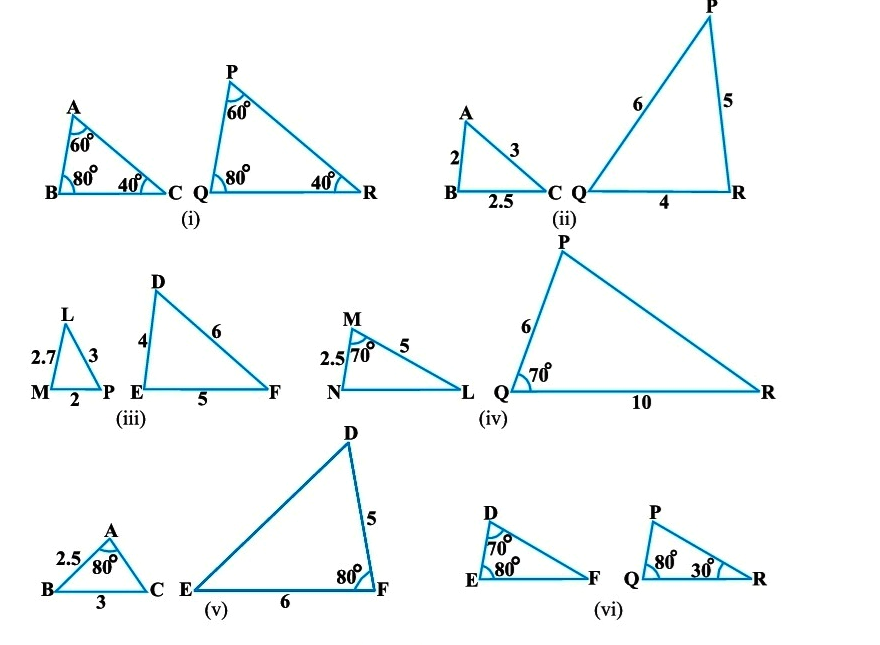
View Answer
Ex. 6.3 Q.2
In Fig. 6.35, Δ ODC ~ Δ OBA, ∠ BOC = 125° and ∠ CDO = 70°. Find ∠ DOC, ∠ DCO and ∠ OAB.

View Answer
Ex. 6.3 Q.3
Diagonals AC and BD of a trapezium ABCD with AB || DC intersect each other at the point O. Using a similarity criterion for two triangles, show that OA/OC = OB/OD.
View Answer
Ex. 6.3 Q.4
In Fig. 6.36, QR/QS = QT/PR and ∠ 1 = ∠ 2. Show that Δ PQS ~ Δ TQR.
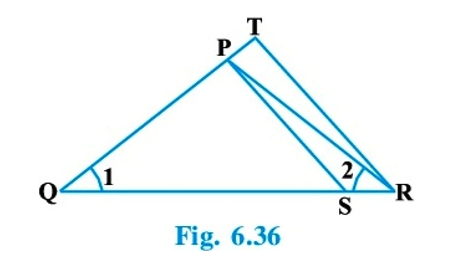
View Answer
Ex. 6.3 Q.5
S and T are points on sides PR and QR of Δ PQR such that ∠ P = ∠ RTS. Show that: Δ RPQ ~ Δ RTS.
View Answer
Ex. 6.3 Q.6
In Fig. 6.37, if Δ ABE ≅ Δ ACD, show that Δ ADE ~ Δ ABC.
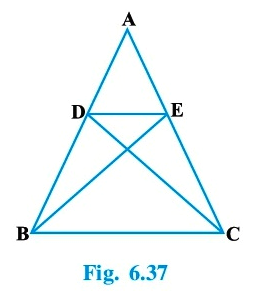
View Answer
Ex. 6.3 Q.7
In Fig. 6.38, altitudes AD and CE of Δ ABC intersect each other at the point P. Show that:
(i) Δ AEP ~ Δ CDP
(ii) Δ ABD ~ Δ CBE
(iii) Δ AEP ~ Δ ADB
(iv) Δ PDC ~ Δ BEC

View Answer
Ex. 6.3 Q.8
E is a point on the side AD produced of a parallelogram ABCD and BE intersects CD at F. Show that Δ ABE ~ Δ CFB.
View Answer
Ex. 6.3 Q.9
In Fig. 6.39, ABC and AMP are two right triangles, right angled at B and M respectively. Prove that:
(i) Δ ABC ~ Δ AMP
(ii) CA/PA = BC/MP
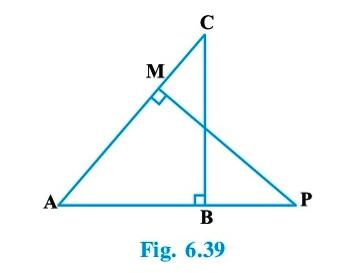
View Answer
Ex. 6.3 Q.10
CD and GH are respectively the bisectors of ∠ ACB and ∠ EGF such that D and H lie on sides AB and FE of Δ ABC and Δ EFG respectively. If Δ ABC ~ Δ FEG, show that:
(i) CD/GH = AC/FG
(ii) Δ DCB ~ Δ HGE
(iii) Δ DCA ~ Δ HGF
View Answer
Ex. 6.3 Q.11
In Fig. 6.40, E is a point on side CB produced of an isosceles triangle ABC with AB = AC.
If AD ⊥ BC and EF ⊥ AC, prove that Δ ABD ~ Δ ECF.

View Answer
Ex. 6.3 Q.12
Sides AB and BC and median AD of a triangle ABC are respectively proportional to sides PQ and QR and median PM of Δ PQR (see Fig. 6.41). Show that: Δ ABC ~ Δ PQR.
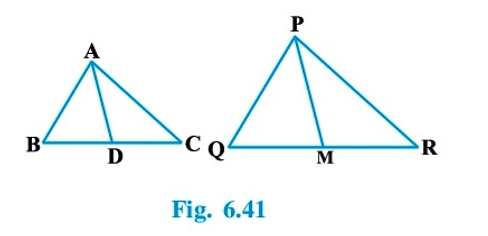
View Answer
Ex. 6.3 Q.13
D is a point on the side BC of a triangle ABC such that ∠ ADC = ∠ BAC. Show that CA2 = CB * CD.
View Answer
Ex. 6.3 Q.14
Sides AB and AC and median AD of a triangle ABC are respectively proportional to sides PQ and PR and median PM of another triangle PQR.
Show that: Δ ABC ~ Δ PQR.
View Answer
Ex. 6.3 Q.15
A vertical pole of length 6 m casts a shadow 4 m long on the ground and at the same time a tower casts a shadow 28 m long. Find the height of the tower.
View Answer
Ex. 6.3 Q.16
If AD and PM are medians of triangles ABC and PQR, respectively where Δ ABC ~ Δ PQR, prove that AB/PQ = AD/PM.
View Answer